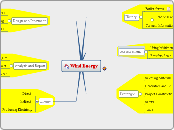Wind Energy
History
Earlist forms
History of wind powerFrom Wikipedia, the free encyclopedia• Interested in contributing to Wikipedia? •Jump to: navigation, searchWind turbineHistoryDesignManufacturersSpecial turbinesEarly examples of wind power machines were used in Persia as early as 200 BC, and were introduced into the Roman Empire by 250 AD. However, the first practical windmills were built in Sistan, Afghanistan, from the 7th century, by the Rashidun caliph Umar (634-644). These were verticle axle windmills, which had long vertical shafts with rectangle shaped blades.[1] Made of six to twelve sails covered in reed matting or cloth material, these windmills were used to grind corn and draw up water, and were used in the gristmilling and sugarcane industries.[2]By the 14th century Dutch windmills were in use to drain areas of the Rhine River delta. In Denmark by 1900 there were about 2500 windmills for mechanical loads such as pumps and mills, producing an estimated combined peak power of about 30 MW. The first windmill for electricity production was built in Scotland in July 1887 by Prof James Blyth of Anderson's College, Glasgow (the precursor of Strathclyde University[3]. Across the Atlantic, in Cleveland, Ohio a larger and heavily engineered machine was designed in winter 1887 by Charles F. Brush[4] , this was built by his engineering company at his home and was operating in 1888[5]. It seems that by 1908 there were 72 wind-driven electric generators from 5 kW to 25 kW. The largest machines were on 24 m (79 ft) towers with four-bladed 23 m (75 ft) diameter rotors. In Denmark wind power was an important part of a decentralized electrification in the first quarter of the 20th century, partly because of the Danish wind power scientist Poul la Cour from his first practical development in 1891 at Askov.The world's first megawatt-size wind turbine on Grandpa's Knob, Castleton, VermontThe world's first megawatt-size wind turbine on Grandpa's Knob, Castleton, VermontBy the 1930s windmills were mainly used to generate electricity on farms, mostly in the United States where distribution systems had not yet been installed. In this period, high tensile steel was cheap, and windmills were placed atop prefabricated open steel lattice towers. A forerunner of modern horizontal-axis wind generators was in service at Yalta, USSR in 1931. This was a 100 kW generator on a 30 m (100 ft) tower, connected to the local 6.3 kV distribution system. It was reported to have an annual load factor of 32 per cent, not much different from current wind machines.In 1941 the world's first megawatt-size wind turbine was connected to the local electrical distribution system on Grandpa's Knob in Castleton, Vermont, USA. This 1.25 MW Smith-Putnam turbine operated for 1100 hours before a blade failed at a known weak point, which had not been reinforced due to war-time material shortages. In the 1940s, the U.S. had a rural electrification project that killed the natural market for wind-generated power, since network power distribution provided a farm with more dependable usable energy for a given amount of capital investment.In the 1970s many people began to desire a self-sufficient life-style. Solar cells were too expensive for small-scale electrical generation, so some turned to windmills. At first they built ad-hoc designs using wood and automobile parts. Most people discovered that a reliable wind generator is a moderately complex engineering project, well beyond the ability of most romantics. Some began to search for and rebuild farm wind-generators from the 1930s, of which Jacobs wind generators were especially sought after.
Rhode Island Early Wind Mills
Longfellow Wind MillLocation:In East Greenwich, on Division St west of Rt 1 about 0.5 mile. Kent Co - RIBoyds Wind MillLocation:In Paradise park in Newport. On Gray Craig Rd. east of Paradise Rd.Newport Co - RIJamestown Wind MillLocation:On N Main Rd, south of Rt 138 in Jamestown.Newport Co - RIPrescott Wind MillLocation:North of Newport about 3 miles on the east side of Rt 114 - at Prescott Farms.Newport Co - RI
Currunt Information
Measurement
Using Multimeter
Beaufort Scale
Prototype
Selecting Materials
Generators and LEDs
Project Construction
Safety
Tools
Design and Innovation
The Design Process
Brainstorming
Detailed Drawings
Analysis and Report
Energy Quiz
Measurement Sheet
Present Project
Energy
Direct
Indirect
Producing Electricity
